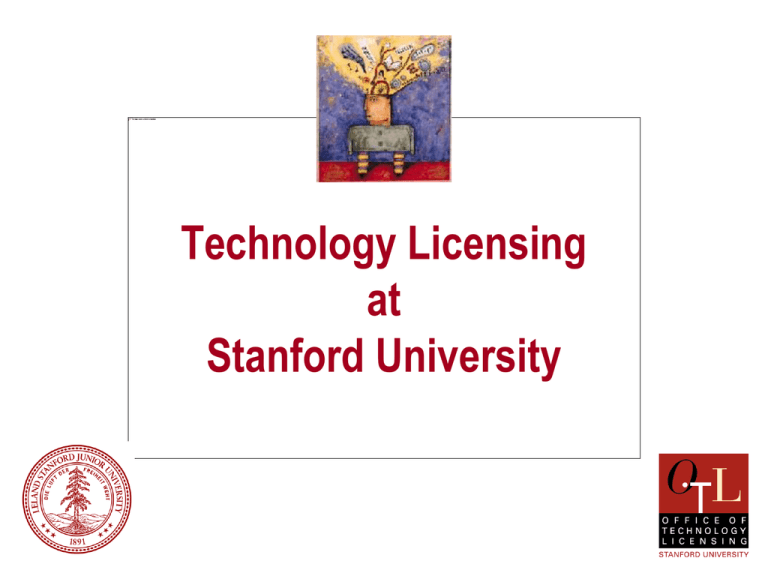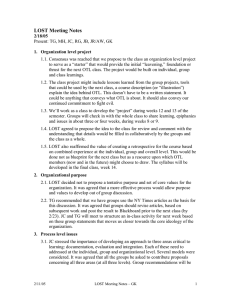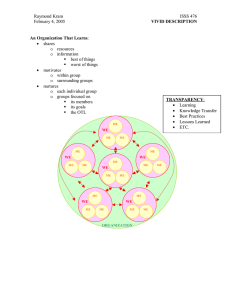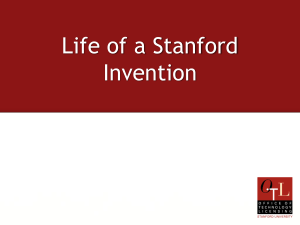Technology Licensing at Stanford University
advertisement

Technology Licensing at Stanford University Overview • Background and Policies • OTL Facts and Figures • OTL Process: Invention to License University-Industry Technology Transfer Research results from lab Start-up companies and large corporations Mechanisms Graduated students Publications Seminars, conferences, etc. Faculty consulting Industry sponsored research Industrial affiliate programs IntellectualProperty propertyLicensing licensing Intellectual New products in marketplace University-Government Interactions Government University Bayh-Dole Act • • Created uniform patent policy regarding inventions made under federally-funded research programs Encouraged universities to participate in technology transfer activities Bayh-Dole Act (U.S. Public Law 96-517) • University may elect to retain title to inventions developed under federally-funded research programs • University grants royalty-free nonexclusive license to government • Any company holding an exclusive license must substantially manufacture the product in the U.S. • In marketing of an invention, University must give preference to small business firms (< 500 employees) • University must share with the inventor(s) a portion of any revenue received from licensing (Sources: COGR Publication “The Bayh-Dole Act: A Guide to the Law and Implementing Regulations”, 37 CFR Part 401, 35 USC 200-212) Stanford Facts for 2008 • 7 Schools – Business, Earth Sciences, Education, Engineering, Humanities and Sciences, Law, and Medicine • • • 1,829 Faculty members Students (6,759 undergraduate and 8,186 graduate) Finances (FY 2007-2008) – $3.4 billion budget • $1.06 billion in sponsored research, including SLAC (87% by federal government sponsors) • additional $132.1 million in part through 55 industrial affiliate programs – $17.2 billion endowment (http://www.stanford.edu/home/stanford/facts/) Office of Technology Licensing (OTL) Mission To promote the transfer of Stanford technology for society’s use and benefit while generating unrestricted income to support research and education. Technology Transfer Portfolio Patents Copyrightable Material Software Biological Material Semiconductor Maskworks Licensing: Inventions to New Products OTL decides IP protection for invention and markets invention broadly Federal & industry research money Stanford researcher discovers new invention & submits disclosure ,© OTL licenses invention to Company Additional research funding Company makes new products Company pays royalties to University Stanford’s Intellectual Property Policy • Patentable Technology University takes title to all inventions created with more than incidental use of University resources www.stanford.edu/dept/DoR/rph/5-1.html • Copyrighted Works University takes title to copyrightable works created with significant University resources www.stanford.edu/dept/DoR/rph/5-2.html • SU-18 Patent and Copyright Agreement www.stanford.edu/dept/DoR/rph/su18.html Stanford’s Royalty Distribution Policy • • Cash Royalties from Issue, Minimums, Earneds Net Royalties = Cash Royalties minus 15% for administrative expenses minus out-of-pocket expenses (e.g. patent costs) 1/3 of Net Royalties to Inventors 1/3 of Net Royalties to Inventors' Department 1/3 of Net Royalties to Inventors' School OTL: Notable Stanford Inventions 1970 – OTL Established 1971 – FM Sound Synthesis ($22.9M) 1974 – Recombinant DNA ($255M) 1981 – Phycobiliproteins ($46.4M), Fiber Optic Amplifier ($40M), MINOS ($3.8M) 1982 – Amplification of Genes ($30M) 1984 – Functional Antibodies ($191M) 1986 – CHEF Electrophoresis ($2.25M) 1990-1992 – Discrete Multi-tone technologies for DSL ($29M) 1996 – Improved Hypertext Searching - GoogleTM ($337M) 2009 – the next big thing ??? OTL: Disclosure and Licensing History 1970 2008 Cumulative Active Disclosures 28 430 7500 ~3000 Licenses* 3 107 2800 ~1000 $50,000 $62.5 M $1.2 B 2 30 Royalty Income Staff * Majority of disclosures are never licensed; many disclosures have one license; some disclosures have multiple licenses OTL: The Upside • In FY07-08, $62.5 million in royalties Royalty ($ millions) 60 • From 1970 through 2008, ~$1.2 billion cumulative royalties 40 20 0 FY69-70 FY76-77 FY83-84 FY90-91 FY97-98 FY04-05 Fiscal Year • Typically, 10 to 15 years may elapse between initial invention disclosure and any significant royalties OTL: Looking Closely at Royalties 300 • # of Disclosures 250 In FY07-08, $62.5 million from 546 disclosures – 33 out of 546 disclosures generated over $100,000 each – 3 out of 33 generated over $1 million each 200 150 • 100 From 1970 through 2008 – 58 inventions generated $1 million or more – 3 out of 7500 is BIG WINNER 50 0 FY03-04 FY05-06 Fiscal Year less than $10K $10K - $100K $100K - $1M $1M - $10M greater than $10 M FY07-08 • Royalties from large portfolio of inventions OTL: Conversion Numbers ~8 disclosures received per week ~ 50% of disclosures are filed as patent applications some disclosures potentially licensable as copyright or biological materials 20 - 25% of disclosures, including those patented, are licensed OTL: Revenue vs. Expenses • $10,000 OTL is self-supporting – 15% of revenue > operating expenses ($ thousands) $8,000 • Operating budget of ~$4.8 million/year • Patent expenses of ~$8.1 million/year • OTL has given ~$43.5 million to Research Incentive Fund administered by Dean of Research $6,000 $4,000 $2,000 $0 FY69-70 FY76-77 FY83-84 FY90-91 FY97-98 FY04-05 Fiscal Year 15% of Revenue Operating Expense OTL: Equity from Licenses • # of Licenses involving Equity 20 Stanford’s philosophy – Equity is one component of a whole financial package – Historically, most income is generated from earned royalties (~$836 M vs. ~$364 M) – Equity is liquidated soon after IPO – We can’t hold equity if licensee conducts clinical trials here 15 10 5 • 0 FY91-92 FY96-97 FY01-02 Fiscal Year FY06-07 Equity from licenses – ~171 companies cumulative – ~90 companies currently – Equity liquidated to date ~$364 million Equity Cash-Out at Stanford* • Equity distribution Equity Cash-out ($ millions) 12 – 15% to OTL – 1/3 of net equity to inventors – 2/3 of net equity to OTL Research and Fellowship Fund 10 8 6 4 • Equity liquidated to date ~$364 million 2 FY 94 -9 5 FY 96 -9 7 FY 98 -9 9 FY 00 -0 1 FY 02 -0 3 FY 04 -0 5* FY 06 -0 7 0 Fiscal Year *Graph does not include liquidation of GoogleTM equity in FY04-05 – Amati (Texas Instruments) $8.0 million – Abrizio (PMC-Sierra) $9.7 million – Google™ $336 million OTL: Invention to License • Steps – Disclosure – Evaluation – Licensing Strategy • File patent? • Market to potential licensees – The License – Maintaining the Relationship • 7 “Licensing Associate & Licensing Liaison” teams – Technical degrees and marketing focus – Responsibility for inventions from cradle-to-grave Evaluation • Discuss with inventors – Inventor provides technical expertise – Inventor may also provide industry contacts • Discuss with others at OTL • Contact industry experts • Typical criteria – Invention development status – Inventor profile – Intellectual property position – Commercial potential – Licensing potential The Main Question Does it have the potential to create meaningful income for the University? Licensing Strategy • A license is a legal document regarding intellectual property rights in exchange for good and valuable consideration. IP rights Licensor Licensee royalties • Different inventions require different licensing strategies – “ basic new scientific tool” vs. “invention requiring extensive development” – electronics industry vs. biotech industry Patenting Decision • Can we license as tangible research property (TRP)? • Can we license as it as copyright? • Is it patentable and enforceable? • Has it been publicly disclosed? Patent Prosecution • Licensing professional manages outside counsel – Technology expertise – Patent agent vs. Patent attorney • Patent costs – Typically $25,000 to $35,000 over life of U.S. patent • USPTO fees – if invention is not licensed, pay small entity fees • Patent attorney/agent costs – Higher patent costs for foreign coverage • PCT application preserves foreign rights while delaying costs • National phase entry if licensee reimburses costs Marketing Strategy • When do we start? – Waiting for publication – Waiting for data • Individual vs. Portfolio • Contact companies and provide information – Shotgun vs. Rifle approach – Sources of leads • Steps – – – – Create marketing content Create list of potential licensees Contact potential licensees Follow-up Types of License Agreements • Option agreement 140 120 • Non-exclusive agreement # of licenses 100 80 • Exclusive agreement 60 40 20 0 FY01-02 FY03-04 FY05-06 FY07-08 Fiscal Year exclusive nonexclusive option – Limited by Field of Use – Limited Period of Time (e.g. earlier of 8 years from Effective Date or 5 years from first commercial sale) Key License Terms • Financial terms – License issue fee – Annual minimum payments – Earned royalties • % of Net Sales • $ per product sold – Reimbursement of patent costs – Equity in start-up companies • Non-financial terms – Definitions – Grant – Development milestones & diligence provisions • Prototype • First Commercial Sale – Warranties and indemnities – Infringement actions – Dispute resolution Licensing: Inventions to New Products OTL decides IP protection for invention and markets invention broadly Federal & industry research money Stanford researcher discovers new invention & submits disclosure ,© OTL licenses invention to Company Additional research funding Company makes new products Company pays royalties to University


